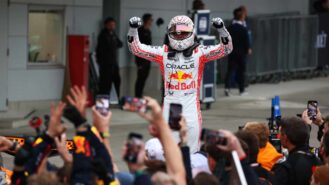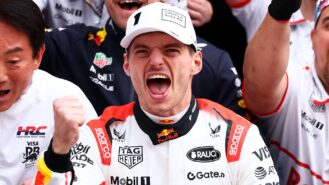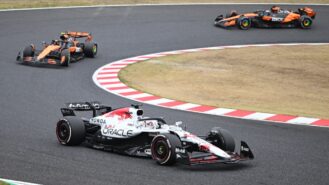
F1 snore-fest shows new cars badly needed: Up/Down Japanese GP
The 2025 Japanese GP showed a much more extreme change than year's technical regulations is needed to make racing at classic F1 tracks interesting
When I interviewed Mark Webber at the beginning of this year, and talked through his Formula 1 career as he prepared for a new life with Porsche, he came up with quite a few opinions that surprised me, not the least of which were his thoughts on how, relative to Sebastian Vettel, Daniel Ricciardo would go in 2014.
“I think,” said Mark, “he’ll give Seb a real hard time in qualifying – it’ll be 50:50 in the first year, I reckon…”
Why was I surprised? Well, in part, I suppose, because at the time we were all struggling to remember a Grand Prix that Vettel hadn’t won. After the summer break in 2013, after all, Sebastian had been unbeaten through the balance of the season. Ricciardo, it is true, had always been highly rated, but it’s fair to say that his appointment as Webber’s successor at Red Bull had been seen as predictable – he had come through the ‘Red Bull system’, and shown well at Toro Rosso – rather than exciting. Indeed many had hoped that the drive would go to Kimi Rӓikkӧnen.

In hindsight, the team’s decision now looks inspired. At Ferrari Rӓikkӧnen has languished with a car that, we are told repeatedly, ‘doesn’t suit his style’, while few would dispute that Ricciardo (with Valtteri Bottas lurking close by) has been the revelation of the season, comfortably exceeding even Webber’s expectations. The Mercedes drivers apart, only Daniel has won a Grand Prix in 2014, and so far he has done it twice.
Vettel, meantime, has been a great disappointment, perhaps causing those to think again who last year claimed that he was now definitively the best driver in F1. I go back to Webber again, and his belief that Ricciardo would push Vettel: “Seb exploited the blown floor brilliantly – far better than I did – but it’s gone now, and it’ll be interesting to see if he’s the same driver with the back end moving around a bit…”
Red Bull people have inevitably sought to put a favourable spin on Vettel’s performances in 2014, reminding us constantly of the shortcomings of Renault’s power unit, suggesting that Seb is ‘tired’ after winning four consecutive World Championships, and is taking time to acclimatise to this new generation of F1 car, which in its early guise does not – as with Rӓikkӧnen – suit his style…

That said, Vettel’s performances have certainly improved of late, and perhaps, after this summer break, he will begin to revive at least some of the memories of when he seemed unstoppable.
It is undeniable that Renault has struggled with horsepower in 2014, particularly against Mercedes, surely confirming that the RB10 is yet another sensationally good car from Red Bull. Given its deficiencies in a straight line, though, it seems unlikely to trouble Messrs Rosberg and Hamilton too much in the next two Grands Prix, at Spa and Monza.
This, for many people – myself included – is the high point of the F1 season: back-to-back races at classic circuits. Some, including Webber, suggest that the best track in the world is now Suzuka, but if, as Mark contends, “They’ve even softened Spa off, so it’s not what it was…”, still the home of the Belgian Grand Prix retains its allure.

Twenty years ago, though, we went there with heavy hearts. This was August 1994, a few months since the deaths at Imola of Roland Ratzenberger and Ayrton Senna, and Formula 1 was enmeshed – not surprisingly – in a period of intense self-examination.
Two weeks after Imola, in a press conference on the Friday morning at Monaco, Max Mosley, president of the FIA, announced a raft of technical and procedural changes, some to be introduced immediately, some to be phased in later, all of them in the interests of safety.
Instant rule changes would normally have been precluded by the terms of the Concorde Agreement, but ‘safety’ was a different matter. “The time has come,” Max said, “because of the gravity of the situation – and the force of public opinion – to push aside such considerations, and simply do what is right, in the general interests of the sport.”
Mosley admitted that he had been stunned by the worldwide reaction to the events at Imola. “To me,” he said, “being a Formula 1 driver is like being a fighter pilot – there’s a small, but finite, chance that you will come unstuck. It doesn’t alter the fact that it’s very sad, but it can happen. However, the public doesn’t seem to react like that these days.”

Mosley was right. In 1982, when Gilles Villeneuve and Riccardo Paletti lost their lives, the general press response was what it had always been: yes, of course it was tragic and regrettable, but this was a sport that could probably never be safe.
A dozen years on, however, the world had changed very fundamentally. ‘In the name of sport,’ trumpeted the Daily Star on the Monday after Imola, sandwiching the headline between photographs of Senna and Ratzenberger slumped in their cockpits. And at the bottom of the page: ‘These young men died giving us thrills’.
Cheap and sensationalist it may have been, but it reflected a changing world, and there was no doubt that motor racing – if it were to survive – had to change with it. As Mario Andretti put it, “Our sport would never have made it into modern times if it hadn’t addressed safety in the way it finally did. Apart from anything else, sponsors, spending millions of dollars, wanted to celebrate – they did not want to go to funerals…”
Mosley’s ‘emergency’ package of rule changes, announced that morning in Monaco, extended to the cars, of course, but also to the circuits, and, given F1’s jittery state at that time, it was perhaps unsurprising that a degree of over-reaction – almost hysteria – was sometimes apparent.

At the next race, Barcelona, a makeshift chicane – made up of tyre barriers – was demanded by the drivers the night before practice began, but more than one of them murmured to me that it was more dangerous than the following corner it sought to protect.
Under the FIA’s newly-introduced safety initiative, changes were also required at Spa, where the fabled Eau Rouge had been deemed no longer acceptable unless or until a much greater run-off area had been built.
Thus, when we got there in August 1994, we found a new and slow left-hand corner at the bottom of the hill, immediately before the entry to Eau Rouge. This inevitably destroyed one of the great spectacles in motor racing – but more to the point, as Gerhard Berger pointed out, the new corner, still with a flat-out downhill approach, was in itself highly dangerous, with a stout head-on guardrail awaiting anyone who made a mistake or lost his brakes.
The Spa authorities meantime insisted that they would carry out the required work at Eau Rouge, that it would be restored by the time of the 1995 race, and it’s fair to say that many of us doubted them, believing it would be like the ‘temporary’ 70mph speed limit.

We were delighted to be proved entirely wrong. A year on, the new run-off area had indeed been built, and Eau Rouge was back in all its glory. Senna, for one, would have been gratified: a few years earlier, when the very future of Eau Rouge had been in doubt, Ayrton had made a remark that bears repeating: “If you take away Eau Rouge, you take away the reason I do this…”
It is undeniable that in recent years the challenge of the switchback swerves has been eroded, to the point that Eau Rouge became ‘easy flat’, but hopes are high that, with more power and less downforce, the new generation of F1 cars may find it not so.
Whether those who direct the sport admit it or not – and fiscal considerations always weigh heavier than any other – for diehard F1 fans much of the sport’s appeal has been dissipated by the ceaseless move to more and more ‘cut and paste’ circuits in countries with little or no racing heritage.
“Race tracks,” says Webber, “should be like golf courses – they need to have individual character, to have bespoke peculiarities that make them different, one to another. Ask any of the drivers which circuit they like most, and they’re not going to say Abu Dhabi, that’s for sure…”

As Spa looms, followed by Monza, there is no getting away from the fact that neither the Belgian nor the Italian Grands Prix have anything like the longterm security of more nondescript ‘rich’ races, where the size of the crowd is irrelevant. Bernie Ecclestone, while confirming that Azerbaijan is shortly to be taken into the bosom of the World Championship, recently cast doubts on Monza’s future as a ‘commercially viable’ Grand Prix venue.
For now, at least, Monza survives, and – as with Spa – I am much looking forward to it. I couldn’t hide my dismay, though, when an Italian colleague told me last week of the construction of an asphalt run-off area – in place of the previous gravel trap – at the exit of the iconic Parabolica. Is this to be yet another ‘white line’ corner, with mistakes punished only by stewards?
Formula 1 is tying itself in knots at the moment, panicking about fewer spectators and – more importantly – falling TV audiences. In their clearly uninformed quest to win back the fans, to create new ones, the powers-that-be have come up with a succession of answers – DRS, double points, standing restarts, etc – to questions that didn’t need asking in the first place.

If they really want to know why there is less interest in F1 these days, why do these people not study some of the changes brought to the whole ethos of Grand Prix racing in the recent past, and take a second or two to consider that maybe – just maybe – they might have something to do with it?
Early in 1996 Mosley announced his determination to eliminate ‘life-threatening corners’, of which, in the estimation of the FIA, there were 16. This did not sit well with some of the drivers. It wasn’t that they relished such corners because they were potentially dangerous, but that inevitably it was these which separated the great from the good.
“It’s a matter of finding the right balance, isn’t it?” mused the lamented Ken Tyrrell at the time. “Of working for greater safety – but at the same time ensuring you don’t finish up with something no one wants to watch any more…”

The 2025 Japanese GP showed a much more extreme change than year's technical regulations is needed to make racing at classic F1 tracks interesting

Is Verstappen could be F1 title favourite after his Japanese GP win; McLaren might already need to back one of its drivers; question marks over whether Red Bull made the right choice with Tsunoda. These are the main takeaways from Suzuka

Take a look at some of the best F1 fan outfits from the 2025 Japanese Grand Prix – from replica race suits and helmets to homemade hats

McLaren's dominance came to an end in Japan as Max Verstappen put on a masterclass to show the Woking team's seasons will not be the cakewalk some suspected. Here's how the world champion defeated his rivals